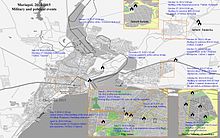
Novoazovsk is a border city on the south-eastern tip of Ukraine, in Kalmiuske Raion (district), in Donetsk Oblast (province). Population: 11,051 ; 12,702 (2001).

The National Guard of Ukraine is the Ukrainian national gendarmerie and internal military force. It is part of the Ministry of Internal Affairs, responsible for public security. Originally created as an agency under the direct control of the Verkhovna Rada on 4 November 1991, following Ukrainian independence, it was later disbanded and merged into the Internal Troops of Ukraine in 2000 by President Leonid Kuchma as part of a "cost-saving" scheme. Following the 2014 Revolution of Dignity, amidst the Russian intervention, the National Guard was re-established, and the Internal Troops were disbanded.

The war in Donbas, also known as the Donbas war, was a phase of the Russo-Ukrainian War in the Donbas region of Ukraine. The war began in April 2014, when a commando unit headed by Russian citizen Igor Girkin seized Sloviansk in Donetsk oblast. The Ukrainian military launched an operation against them. The war continued until subsumed by the Russian invasion of Ukraine in 2022.
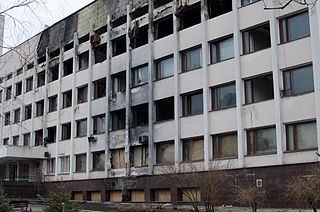
During the 2014 pro-Russian unrest in Ukraine in the aftermath of the Revolution of Dignity, the city of Mariupol, in Donetsk Oblast, saw skirmishes break out between Ukrainian government forces, local police, and separatist militants affiliated with the Donetsk People's Republic. Government forces withdrew from Mariupol on 9 May 2014 after heavy fighting left the city's police headquarters gutted by fire. These forces maintained checkpoints outside the city. Intervention by Metinvest steelworkers on 15 May 2014 led to the removal of barricades from the city centre, and the resumption of patrols by local police. Separatists continued to operate a headquarters in another part of the city until their positions were overrun in a government offensive on 13 June 2014.

The 12th Special Operations Brigade "Azov" is a formation of the National Guard of Ukraine formerly based in Mariupol, in the coastal region of the Sea of Azov, from which it derives its name. It was founded in May 2014 as the Azov Battalion, a self-funded volunteer militia under the command of Andriy Biletsky, to fight Russian-backed forces in the Donbas War. It was formally incorporated into the National Guard on 11 November 2014, and redesignated Special Operations Detachment "Azov", also known as the Azov Regiment. In February 2023, the Ukrainian Ministry of Internal Affairs announced that Azov was to be expanded as a brigade of the new Offensive Guard.

The Donbas Battalion is a unit of the National Guard of Ukraine under the Ministry of Internal Affairs of Ukraine and formerly based in Severodonetsk. It was created in 2014 as a volunteer unit by Semen Semenchenko after the Russian occupation of Crimea and an anticipated invasion of continental Ukraine. The unit was formed in the spring during the 2014 pro-Russian unrest in Ukraine. The unit was initially formed as an independent force, but has been fully integrated into the National Guard as the 2nd Special Purpose Battalion "Donbas" in the 15th Regiment of the National Guard.
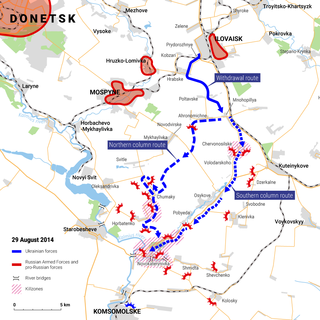
The Battle of Ilovaisk started on 7 August 2014, when the Armed Forces of Ukraine and pro-Ukrainian paramilitaries began a series of attempts to capture the city of Ilovaisk from pro-Russian insurgents affiliated with the Donetsk People's Republic (DPR) and detachments of the Russian Armed Forces. Although Ukrainian forces were able to enter the city on 18 August, they were encircled between 24 and 26 August by overwhelming Russian military forces that crossed the border, joining the battle. After days of encirclement, Ukrainian forces rejected the DPR's proposal to open a humanitarian corridor on the condition that they abandon their armored vehicles and ammunition, and on the morning of 29 August 2014 began to leave Ilovaisk with their weapons. The Russian side opened fire on the evacuating Ukrainian soldiers, many of whom died whilst trying to escape.
Insurgents affiliated with the Donetsk People's Republic (DPR), backed by Russian troops, opened a new front in the war in Donbas on 25 August 2014, when they attacked the Ukrainian government-controlled city of Novoazovsk in southern Donetsk. Government forces were forced to retreat from Novoazovsk to the city of Mariupol, leaving DPR forces in control.

The Second Battle of Donetsk Airport was an engagement between the Ukrainian military and Russian military and its proxy forces of the Donetsk People's Republic (DPR) during the War in Donbas. An earlier battle in May 2014 had left Donetsk International Airport in Ukrainian control. Despite a ceasefire agreement, the Minsk Protocol, in place since 5 September 2014, fighting broke out between the warring parties on 28 September 2014.
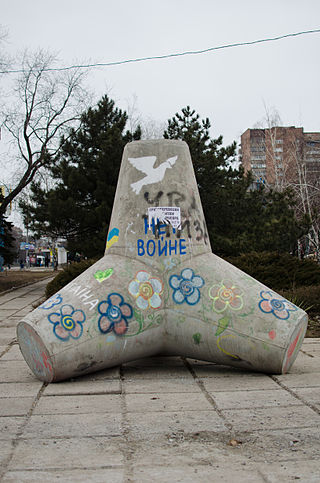
A rocket attack on Mariupol was launched on 24 January 2015 by Russian and pro-Russian forces against the strategic maritime city of Mariupol, defended by Ukrainian government forces. Mariupol had come under attack multiple times in the previous year in the course of the War in Donbas, including in May–June 2014, when the city was under the control of Russian controlled forces; and in the September 2014 offensive.

The Battle of Debaltseve was a military confrontation in the city of Debaltseve, Donetsk Oblast, between the pro-Russian separatist forces of the Donetsk People's Republic (DPR) and Luhansk People's Republic (LPR), and the Ukrainian Armed Forces, starting in mid-January 2015 during the war in the Donbas region. The Russian forces composed mostly of "Wagner Group" soldiers recaptured Debaltseve, which had been under Ukrainian control since a counter-offensive by government forces in July 2014. The city lay in a "wedge" of Ukrainian-held territory bordered by the DPR on one side, and the LPR on the other, and is a vital road and railway junction.

The Shyrokyne standoff was a battle for the control of the strategic village of Shyrokyne, located approximately 11 km (6.8 mi) east of Mariupol city limits, between Ukrainian forces led by the Azov Regiment, and Russian-backed separatists, between February and July 2015. It was part of the larger war in Donbas. On 10 February 2015, the Azov Regiment launched a surprise offensive against pro-Russian separatists associated with the Donetsk People's Republic (DPR) with the aim of pushing the separatist forces away from Mariupol city limits. The village is located just 10 km (6.2 mi) from the Ukrainian-controlled city of Mariupol, and was used as a launching point for separatist attacks on the city, which served as the administrative centre of Donetsk Oblast whilst DPR forces control Donetsk city. Fighting continued until 3 July 2015, when DPR forces unilaterally withdrew from Shyrokyne. Subsequently a cease-fire was declared in the area.

Shyrokyne or Shirokino is a village in the Mariupol Raion of Donetsk Oblast, Ukraine.
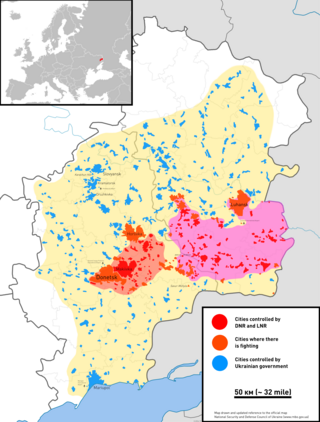
This is a timeline of the war in Donbas for the year 2014.

This is a timeline of the war in Donbas for the year 2015.

This is a timeline of the war in Donbas, from 1 January 2017. The timeline follows an ongoing conflict between Ukraine and anti-government pro-Russian separatists supported by Russian troops in the Donbas region in eastern Ukraine.

The siege of Mariupol began on 24 February 2022 and lasted until 20 May, as part of the Russian invasion of Ukraine. It saw fighting between the Russian Armed Forces and the Ukrainian Armed Forces for control over the city of Mariupol in southeastern Ukraine. Lasting for almost three months, the siege ended in a victory for Russia and the Donetsk People's Republic, as Ukraine lost control of the city amidst Russia's eastern Ukraine offensive and southern Ukraine offensive; all Ukrainian troops remaining in the city surrendered at the Azovstal Iron and Steel Works on 20 May 2022, after they were ordered to cease fighting.

Ukraine's easternmost oblasts, Donetsk, Luhansk, and Kharkiv, have been the site of an ongoing theatre of operation since the start of the Russian invasion of Ukraine in February 2022.
The battle of Volnovakha was a military engagement which lasted from 25 February 2022 until 12 March 2022, on the eastern front of the Russian invasion of Ukraine. Russian and DPR forces engaged Ukrainian forces at the small city of Volnovakha in Donetsk Oblast, which was located close to the pre-invasion front line.

The 12th Brigade of Operational Assignment was a military formation of the National Guard of Ukraine. It was part of the Eastern operational territorial association. It was based in Mariupol, Donetsk Oblast.

